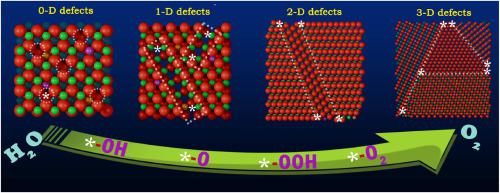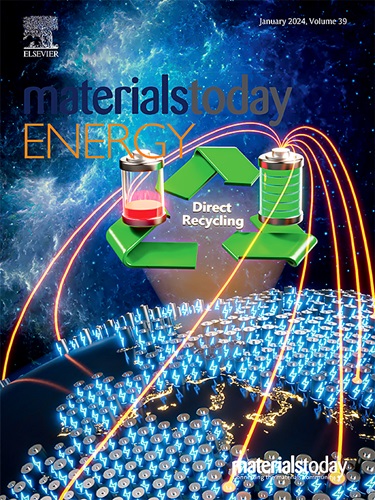Unveiling the kinetics of oxygen evolution reaction in defect-engineered B/P-incorporated cobalt-oxide electrocatalysts
IF 8.6
2区 材料科学
Q1 CHEMISTRY, PHYSICAL
引用次数: 0
Abstract
Defect-rich transition-metal oxide electrocatalysts hold great promise for alkaline water electrolysis due to their enhanced activity and stability. This study presents a new strategy that significantly improve the OER activity of Co-oxide nanosheets through incorporation of B and P (B/P-CoO NS), eventually leading to abundant surface defects and oxygen vacancies. The B/P-CoO NS demonstrates low overpotential of 220 mV to achieve 10 mA/cm. The electrochemical and kinetic studies coupled with conventional morphological and structural characterizations, reveal that various crystalline defects like vacancies, dislocations, twin planes, and grain boundaries play crucial roles in promoting the OH ion adsorption, the formation of intermediates, and the desorption of oxygen molecules. The industrial viability of the developed electrocatalyst is substantiated through assessments under harsh industrial conditions of 6 M KOH at 60 °C in a zero-gap single-cell alkaline electrolyzer which achieves 1 A/cm at 1.95 V. Chronoamperometry tests (100 h) highlight remarkable robustness of the electrocatalyst. This work establishes a new strategy to fabricate defect-rich OER electrocatalysts, setting a precedent to achieve better OER rates with non-noble materials.

揭示缺陷工程 B/P 嵌入氧化钴电催化剂中氧进化反应的动力学原理
富含缺陷的过渡金属氧化物电催化剂具有更高的活性和稳定性,因此在碱性水电解方面大有可为。本研究提出了一种新策略,通过加入 B 和 P(B/P-CoO NS),最终产生丰富的表面缺陷和氧空位,从而显著提高氧化钴纳米片的 OER 活性。B/P-CoO NS 具有 220 mV 的低过电位,可达到 10 mA/cm。电化学和动力学研究以及传统的形态和结构特征分析表明,空位、位错、孪晶面和晶界等各种晶体缺陷在促进 OH 离子吸附、中间产物形成和氧分子解吸方面起着至关重要的作用。在零间隙单电池碱性电解槽中,在 60 °C、6 M KOH 的苛刻工业条件下进行了评估,在 1.95 V 的电压下达到 1 A/cm 的电流,从而证实了所开发电催化剂的工业可行性。计时器测试(100 小时)凸显了该电催化剂的卓越稳健性。这项工作确立了一种制造富缺陷 OER 电催化剂的新策略,为利用非贵金属材料实现更高的 OER 率开创了先例。
本文章由计算机程序翻译,如有差异,请以英文原文为准。
求助全文
约1分钟内获得全文
求助全文
来源期刊

Materials Today Energy
Materials Science-Materials Science (miscellaneous)
CiteScore
15.10
自引率
7.50%
发文量
291
审稿时长
15 days
期刊介绍:
Materials Today Energy is a multi-disciplinary, rapid-publication journal focused on all aspects of materials for energy.
Materials Today Energy provides a forum for the discussion of high quality research that is helping define the inclusive, growing field of energy materials.
Part of the Materials Today family, Materials Today Energy offers authors rigorous peer review, rapid decisions, and high visibility. The editors welcome comprehensive articles, short communications and reviews on both theoretical and experimental work in relation to energy harvesting, conversion, storage and distribution, on topics including but not limited to:
-Solar energy conversion
-Hydrogen generation
-Photocatalysis
-Thermoelectric materials and devices
-Materials for nuclear energy applications
-Materials for Energy Storage
-Environment protection
-Sustainable and green materials
 求助内容:
求助内容: 应助结果提醒方式:
应助结果提醒方式:


